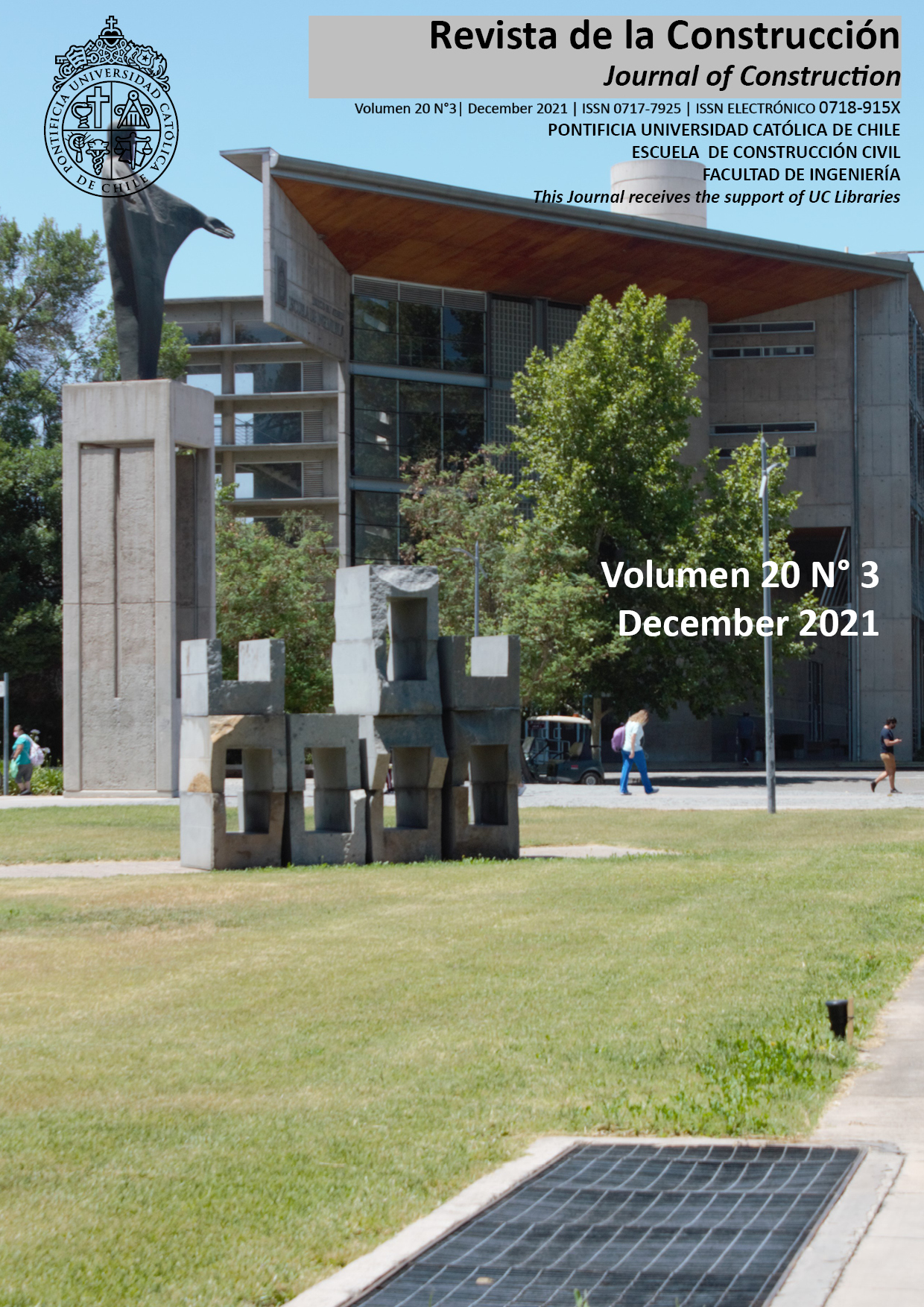Comparison of non-linear dynamic frame response under recorded and numerically generated accelerograms
DOI:
https://doi.org/10.7764/RDLC.20.3.576Keywords:
seismic action, scaled accelerograms, nonlinear dynamics, concrete framesAbstract
The time history analysis of the linear and non-linear response of earthquake resistant structures is a tool increasingly used in practice and required by codes. In this paper, a set of 12 accelerograms was generated numerically with the spectral representation methodology. Another set of 15 accelerograms were selected from a database of earthquake records and scaled with a uniform factor so that the mean spectrum fits the design one. The non-linear dynamic response of two frames of different stiffness and resistance was obtained under the action of the two sets of accelerograms. The global force - displacement results showed a higher coefficient of variation for the set of recorded accelerograms, especially for the structure of lower resistance that has a strong non-linear incursion. The same tendency was obtained for the moment - curvature relationships of beam and column sections, with higher dispersions compared to the global results. In addition, the influence of the vertical acceleration component was analyzed, resulting in a higher incidence in the interior columns of the frames.
Downloads
References
ASCE 7-16. (2016). American Society of Civil Engineers.
Baker, J. W. (2011). Conditional Mean Spectrum: Tool for Ground-Motion Selection. Journal of Structural Engineering, 137(3). https://doi.org/10.1061/(asce)st.1943-541x.0000215
Bozorgnia, Y., & Campbell, K. W. (2004). The vertical-to-horizontal response spectral ratio and tentative procedures for developing simplified V/H and vertical design spectra. Journal of Earthquake Engineering, 8(2). https://doi.org/10.1080/13632460409350486
Dehghani, M., & Tremblay, R. (2016). Robust period-independent ground motion selection and scaling for effective seismic design and assessment. Journal of Earthquake Engineering, 20(2). https://doi.org/10.1080/13632469.2015.1051635
FEMA P-58-I. (2012). Seismic Performance Assessment of Buildings - Volume 1 – Methodology.
FEMA P-750. (2009). NEHRP recommended seismic provisions for new buildings and other structures.
Filip C. Filippou, & Ahmad Issa. (1988). Nonlinear Analysis of Reinforced Concrete Frames Under Cyclic Load Reversals. Computers , 13(1–3).
Grant, D. N., & Diaferia, R. (2013). Assessing adequacy of spectrum-matched ground motions for response history analysis. Earthquake Engineering and Structural Dynamics, 42(9). https://doi.org/10.1002/eqe.2270
Ha, S. J., & Han, S. W. (2016). A Method for Selecting Ground Motions that Considers Target Response Spectrum Mean and Variance as Well as Correla-tion Structure. Journal of Earthquake Engineering, 20(8). https://doi.org/10.1080/13632469.2016.1138162
Hancock, J., Watson-Lamprey, J., Abrahamson, N. A., Bommer, J. J., Markatis, A., McCoy, E. M. M. A., & Mendis, R. (2006). An improved method of matching response spectra of recorded earthquake ground motion using wavelets. Journal of Earthquake Engineering, 10. https://doi.org/10.1080/13632460609350629
INPRES - CIRSOC 103. (2018). Reglamento Argentino para Construcciones Sismorresistentes. Parte I, Construcciones en general.
Katsanos, E. I., Sextos, A. G., & Manolis, G. D. (2010). Selection of earthquake ground motion records: A state-of-the-art review from a structural engi-neering perspective. In Soil Dynamics and Earthquake Engineering (Vol. 30, Issue 4). https://doi.org/10.1016/j.soildyn.2009.10.005
Möller, O., & Foschi, R. O. (2003). Reliability Evaluation in Seismic Design: A Response Surface Methodology. Earthquake Spectra, 19(3). https://doi.org/10.1193/1.1598200
Möller, O., Foschi, R. O., Ascheri, J. P., Poliotti, M., Sierra, P. L., & Grossman, S. (2017). Evaluación Numérica del Desempeño Sísmico Considerando Incertidumbres. Mecánica Computacional, 35, 619–635.
Möller, O., Foschi, R. O., Ascheri, J. P., Rubinstein, M., & Grossman, S. (2015). Optimization for performance-based design under seismic demands, including social costs. Earthquake Engineering and Engineering Vibration, 14(2). https://doi.org/10.1007/s11803-015-0025-2
Pacific Earthquake Engineering Research Center. (2019). PEER Strong ground motion database. https://peer.berkeley.edu/peer-strong-ground-motion-databases
Shinozuka, M., & Deodatis, G. (1991). Simulation of stochastic processes by spectral representation. Applied Mechanics Reviews, 44(4). https://doi.org/10.1115/1.3119501
Taucer, F. F., Spacone, E., & Filippou, F. C. (1991). A Fiber Beam-Column Element for Seismic Response Analysis of Reinforced Concrete Structures. In Ucb/Eerc-91/17.
Taylor, R. L., Filippou, F. C., Saritas, A., & Auricchio, F. (2003). A mixed finite element method for beam and frame problems. Computational Mechanics, 31(1-2 SPEC.). https://doi.org/10.1007/s00466-003-0410-y.








